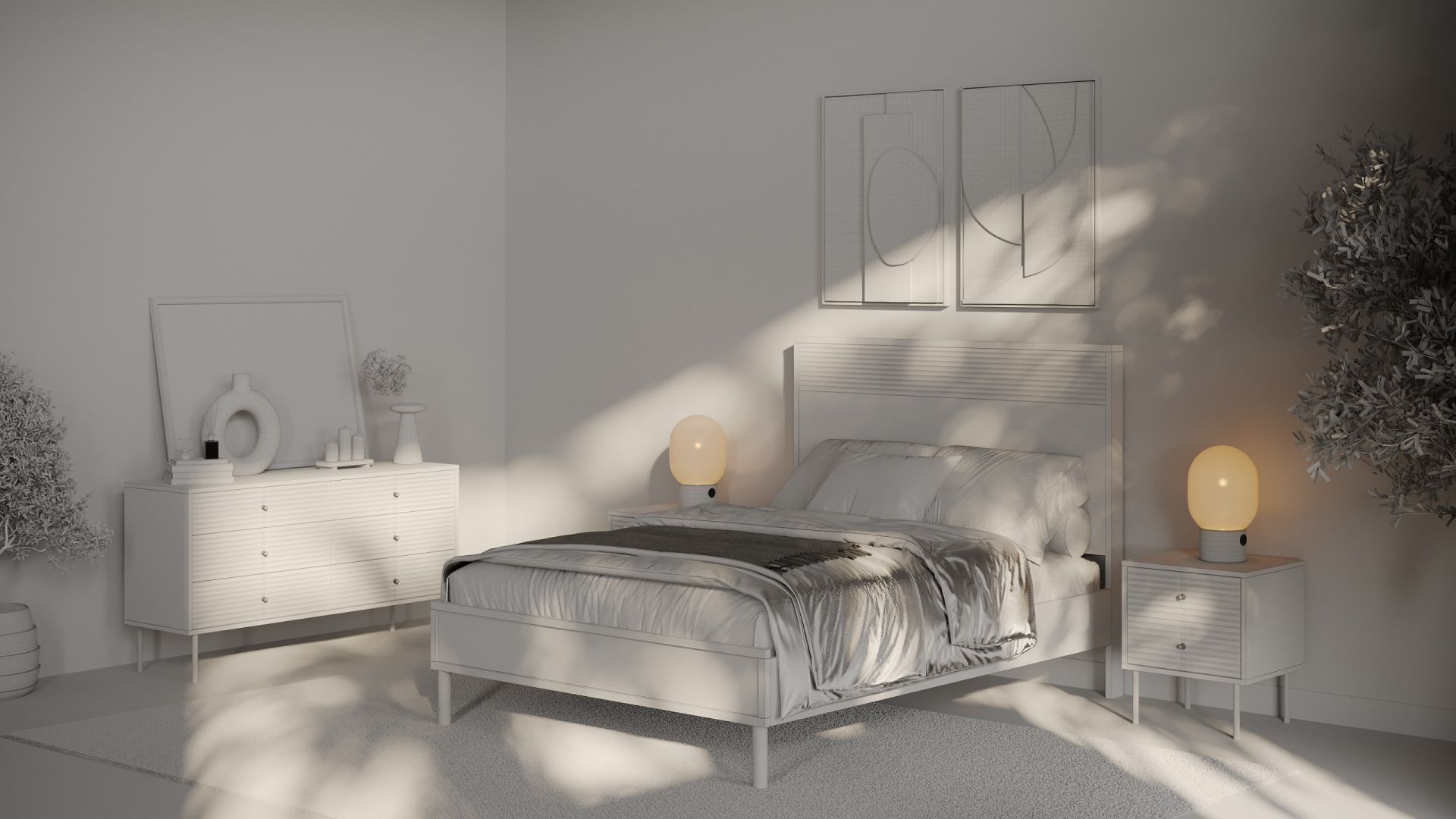Professional 3D modeling is revolutionizing the e-commerce landscape, especially for forward-thinking marketing agencies, furniture companies, home decor brands, and other product-centric businesses. This cutting-edge approach elevates product presentations beyond the ordinary, enabling a vivid, almost tangible customer experience in a digital environment.
By integrating professional modeling, businesses can transform their online showcases into immersive visual narratives. This not only captivates the audience but also provides an accurate representation of products, building up trust and engagement. For brands looking to differentiate themselves in the bustling online market, professional 3D modeling is an invaluable asset, offering a blend of aesthetic appeal and functional detail that drives consumer interest and sets the stage for market leadership.
At our 3D modeling company , we understand the crucial difference professional 3D modeling makes in bringing brands’ visions to life. This guide breaks down the essentials of 3D modeling, contrasting professional techniques with standard methods.
Discover how our expert approach elevates every project, ensuring your ideas are brought to life with precision, creativity, and unparalleled quality. Perfect for industry veterans and newcomers, we’re here to show you what is 3D modeling for furniture business and how it can upraise your designs, enchase marketing, and boost profits.
Keep reading to learn more!
1. The Essence of 3D Modeling: Shaping the Future of Product Visualization

Professional 3D modeling is an essential digital technique that brings depth and dimension to design, allowing for the meticulous crafting of objects in a three-dimensional space. It’s a process where artists and engineers create a mathematical representation of any surface of an object in three dimensions via specialized software.
The applications of 3D modeling are vast and varied, encompassing everything from architectural visualization, animated films, and video games to engineering and manufacturing.
By utilizing professional 3D modeling, creators can simulate the look, feel, and functionality of objects in a virtual environment, creating an immersive experience long before they are built or manufactured in the real world. Thanks to this, 3D modeling technology transforms simple images into interactive experiences. Customers no longer just look at a product but explore it extensively. They see textures, details, and features up close. This immersive interaction offers a depth of understanding and an appreciation of the product’s value, setting a new standard in consumer experience.
2. Types of 3D Modeling

Different types of 3D modeling, including standard and professional 3D modeling, offer varying levels of detail and realism for digital design. The distinction between standard and professional 3D modeling becomes even more evident when considering specific attributes like materials, lighting, and decorative elements. These features play a pivotal role in determining the modeled environment’s overall realism and visual appeal.
Here, we delve into the two primary categories that distinguish the field.
Standard 3D Modeling
Standard 3D modeling is defined by its focus on the essential aspects of an object, emphasizing basic shapes and structures without an overabundance of intricate details.
Standard modeling typically includes:
- Realistic Materials: Basic textures and surfaces that mimic real-world materials.
- Realistic Lighting: Standard lighting setups that provide a clear view of the object or scene.
- Basic Furniture and Decor Selection: A limited range of items, often used for general purposes.
- Minimal Variation in Decor Items: Objects such as bottles or books are often cloned, resulting in uniformity rather than diversity.
It captures the general essence of the design, offering a clear but simplified representation that is often quicker to produce and less demanding on resources. This makes it ideal for applications where complex visual fidelity is less critical, such as preliminary product design or basic visualizations.
Professional 3D Modeling
Conversely, professional 3D modeling delves into a much higher level of detail and accuracy, striving to match the real-world counterpart as closely as possible.
- Photorealistic Materials: Textures and surfaces are meticulously crafted to replicate authentic materials’ exact look and feel.
- Nuanced Layered Lighting: Advanced lighting techniques that not only illuminate but also enhance the mood and texture of the materials, requiring additional refinement of the materials themselves.
- Creative Variety in Decor Selection: A diverse array of decor items, differing in shape, size, and color, are carefully selected to complement and balance each other.
- Atmospheric Enhancement through Post-Production: Adjustments in color balance, contrast, and brightness, along with the addition of weather effects, to create a more engaging and dynamic scene.
- Inclusion of Small Imperfections: Deliberate addition of imperfections like creases, folds, and cracks to avoid an overly pristine look, thereby adding character and realism.
- Camera Effects: Implementation of effects such as bloom, glare, glow, and motion blur to mimic the nuances of a camera lens, adding depth and life to the visuals.
Such digital model production involves advanced techniques to replicate textures, light interactions, and subtle nuances like creases and folds, aspiring toward photorealism. This type of modeling is especially pertinent in high-end visualizations, virtual reality, and detailed product mockups where visual precision is paramount. It requires a deep understanding of the artistic and technical sides of 3D modeling software and often involves more time and experience to achieve the desired goal.
3. Technical Differences Software and Tools
Between the simplicity of entry-level programs and the sophistication of advanced systems lies a spectrum of software options. For basic modeling tasks, applications such as Tinkercad and Vectary offer simplicity and ease, perfect for hobbyists or those in the initial stages of learning. These platforms strip back the complexity, presenting a more approachable version of 3D modeling that still retains the power to bring ideas to life.
Professional 3D modeling is the cornerstone of immersive, interactive digital experiences, with tools that shape the frontier of visualization. Within this sphere, standard modeling software like Blender and SketchUp lay the foundation, offering user-friendly interfaces and fundamental features that cater to both beginners and intermediate users. They serve as the launching pad for countless digital creations.
Professional-grade software includes Autodesk Maya, 3ds Max, and Cinema 4D. These advanced platforms boast robust capabilities, from intricate animation to hyper-realistic texturing, providing industry specialists with an exhaustive toolkit. Such tools are engineered to refine precision, enhance efficiency, and expand the limits of digital artistry.
4. Complexity and Detailing

Professional 3D modeling elevates the complexity and detailing that standard modeling cannot match. In standard modeling, the details are often sufficient for basic visualization needs, presenting a model that outlines form and structure with a modest level of depth.
However, with professional 3D modeling, the canvas of creativity expands exponentially. Every stitch in a fabric, the subtle play of light on surfaces, and the delicate textures that give materials their character are captured with meticulous precision. This approach allows for an unparalleled level of realism, making each creation not just a model but a near-perfect reflection of the designer’s intent.
This caliber of detailing is the hallmark of high-end visualizations, interactive media, and virtual prototypes that demand more than just a likeness—they require a mirror to reality. For those seeking the highest level of intricacy in their visuals, professional 3D modeling services are the gateway to exceptional concepts and quality.
To see an example of professional modeling done by our studio, check out our case study about a solid wood bed frame 3D rendering project for Revival Beds.
5. Quality of Textures and Materials
Professional 3D modeling is synonymous with unparalleled quality, textures, and materials, elevating standard modeling to realms of striking realism. Standard modeling sets the stage with basic textures that give a sense of materiality, adequate for conceptual purposes. Yet, it is the domain of professional 3D modeling where the true texture quality shines, with high-resolution maps and advanced rendering techniques that mimic the real world with astonishing accuracy.
The mastery of professional 3D modeling lies in its ability to replicate the nuanced interplay of light and shadow, the subtle imperfections of surfaces, and the authentic look and feel of diverse materials. From the sheen of silk to the ruggedness of brick, every material is rendered with an eye for detail so precise that the virtual and physical become indistinguishable.
6. Lighting and Rendering Settings

Professional 3D modeling illuminates the intersection of art and technology, casting shadows and highlights that transform the flat to the photorealistic. Standard lighting and rendering may produce satisfactory results for simple visuals, but they pale when compared to the capabilities of professional-grade rendering engines.
In professional 3D modeling, lighting is not just a feature; it’s a rich, dynamic element that shapes mood, texture, and depth, critically contributing to the lifelike quality of the scene. Advanced rendering technologies such as ray tracing and global illumination emulate how light interacts with objects, bounces in an environment, and brings materials to life with stunning realism.
The right lighting can turn a model into an experience, encapsulating the subtle warmth of a sunrise or the starkness of urban neon. Professional 3D modeling harnesses this power, turning virtual spaces into emotive landscapes that resonate with viewers on a visceral level. It’s this attention to the luminary details that sets professional services apart, spotlighting their role as pivotal to crafting realities from the realms of imagination.
7. Skill and Expertise

Professional 3D modeling is a craft honed by the skilled hands of artists and technicians whose expertise breathes life into every project. For standard modeling, common skills like basic geometry creation, texturing, and lighting are accessible to beginners, forming the bedrock of 3D artistry.
Yet, it is within the realm of professional 3D modeling that the depth of skill and expertise truly unfolds. Here, specialized knowledge in advanced texturing, complex rigging, and physics-based rendering is paramount. It’s a world where experience counts, not just in years but in the breadth of challenges conquered, ensuring that high-quality results are not a mere chance but a consistent outcome.
In the conclusion of our exploration, the chasm between standard and professional 3D modeling is clear. Each serves a purpose, each a different call. For projects where detail, realism, and technical precision are paramount, professional 3D modeling is the beacon. Our 3D modeling services ensure your product looks great from every angle with crystal-clear visuals.
Reach out to us or book a free demo consultation!
